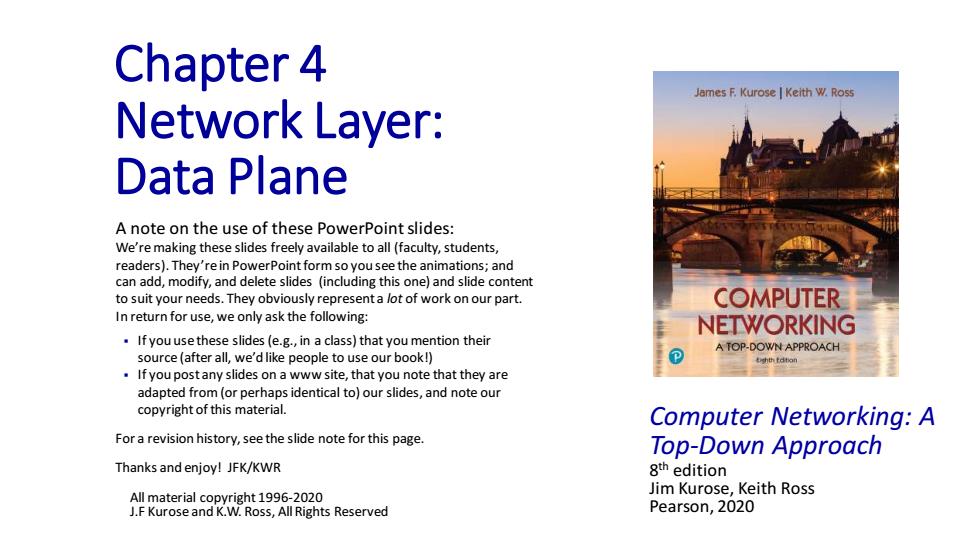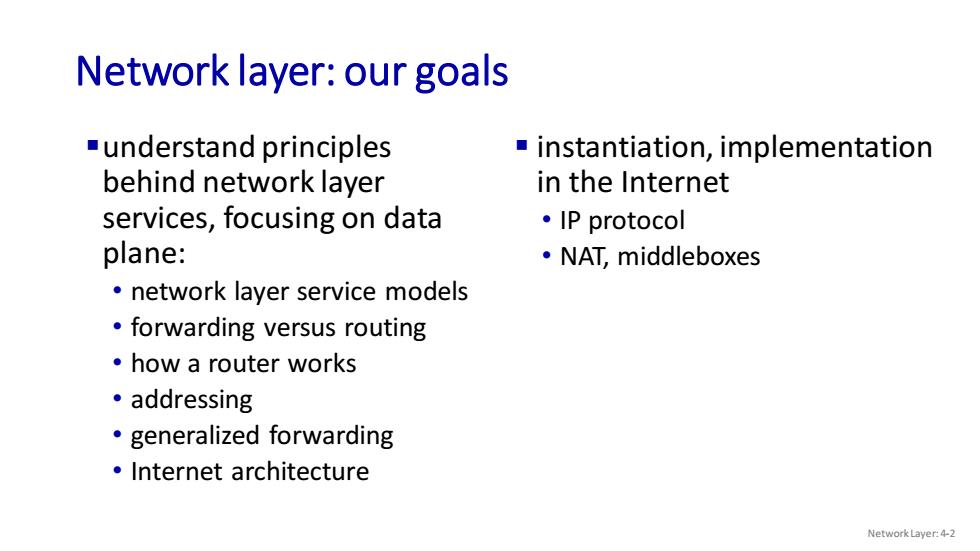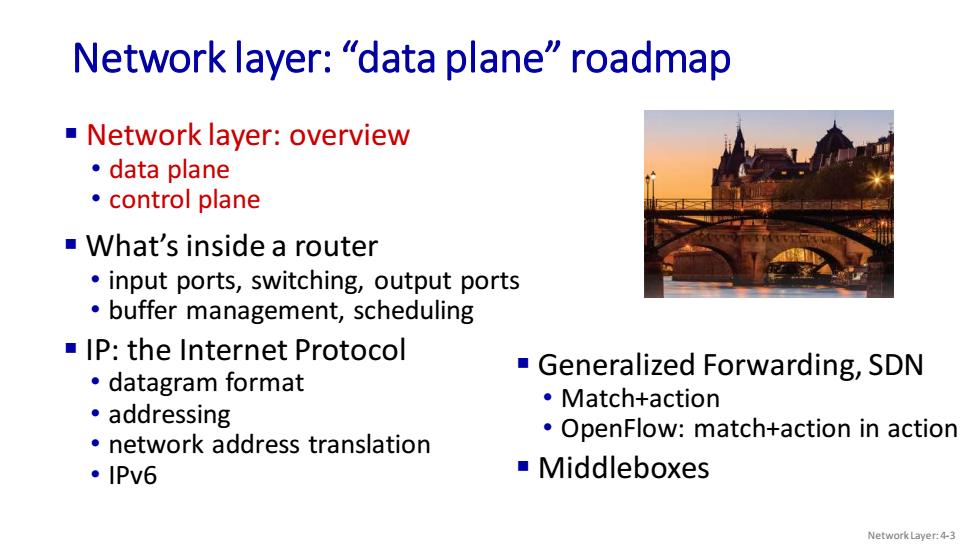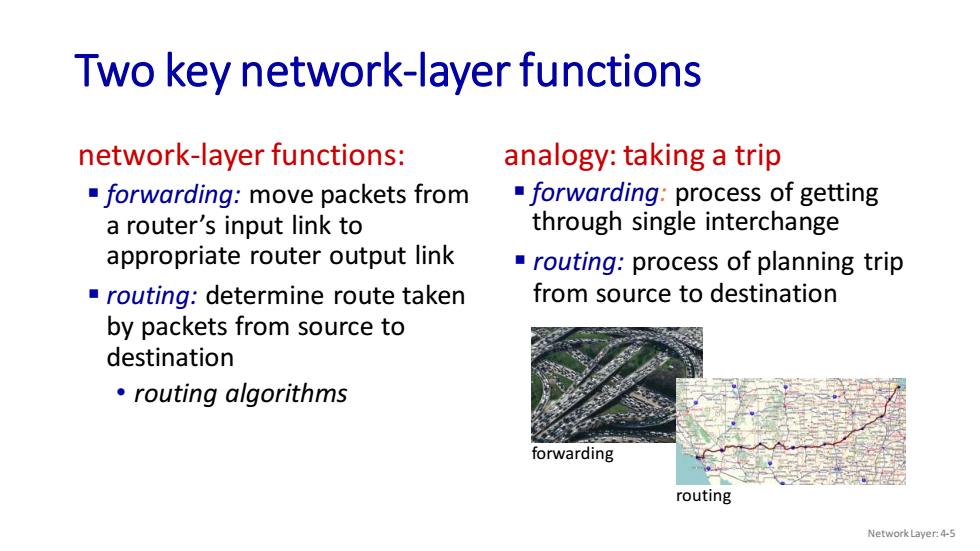
Chapter 4 James F.Kurose Keith W.Ross Network Layer: Data Plane A note on the use of these PowerPoint slides: We're making these slides freely available to all(faculty,students, readers).They're in PowerPoint form so you see the animations;and can add,modify,and delete slides (including this one)and slide content to suit your needs.They obviously represent a lot of work on our part. COMPUTER In return for use,we only ask the following: NETWORKING If you use these slides(e.g.,in a class)that you mention their A TOP-DOWN APPROACH source(after all,we'd like people to use our book!) If you postany slides on a www site,that you note that they are adapted from(or perhaps identical to)our slides,and note our copyright of this material. Computer Networking:A For a revision history,see the slide note for this page. Top-Down Approach Thanks and enjoy!JFK/KWR 8th edition All material copyright 1996-2020 Jim Kurose,Keith Ross J.F Kurose and K.W.Ross,All Rights Reserved Pearson,2020
Computer Networking: A Top-Down Approach 8 th edition Jim Kurose, Keith Ross Pearson, 2020 Chapter 4 Network Layer: Data Plane A note on the use of these PowerPoint slides: We’re making these slides freely available to all (faculty, students, readers). They’re in PowerPoint form so you see the animations; and can add, modify, and delete slides (including this one) and slide content to suit your needs. They obviously represent a lot of work on our part. In return for use, we only ask the following: ▪ If you use these slides (e.g., in a class) that you mention their source (after all, we’d like people to use our book!) ▪ If you post any slides on a www site, that you note that they are adapted from (or perhaps identical to) our slides, and note our copyright of this material. For a revision history, see the slide note for this page. Thanks and enjoy! JFK/KWR All material copyright 1996-2020 J.F Kurose and K.W. Ross, All Rights Reserved

Network layer:our goals -understand principles instantiation,implementation behind network layer in the Internet services,focusing on data ·IP protocol plane: ·NAT,middleboxes network layer service models forwarding versus routing ·how a router works ·addressing generalized forwarding Internet architecture NetworkLayer:4-2
Network layer: our goals ▪understand principles behind network layer services, focusing on data plane: • network layer service models • forwarding versus routing • how a router works • addressing • generalized forwarding • Internet architecture ▪ instantiation, implementation in the Internet • IP protocol • NAT, middleboxes Network Layer: 4-2

Network layer:"data plane"roadmap -Network layer:overview ·data plane ·control plane -What's inside a router input ports,switching,output ports buffer management,scheduling IP:the Internet Protocol Generalized Forwarding,SDN ·datagram format ·Match+action ·addressing OpenFlow:match+action in action network address translation ·1PV6 ■Middleboxes Network Layer:4-3
Network layer: “data plane” roadmap ▪ Network layer: overview • data plane • control plane ▪ Generalized Forwarding, SDN • Match+action • OpenFlow: match+action in action ▪ Middleboxes Network Layer: 4-3 ▪ What’s inside a router • input ports, switching, output ports • buffer management, scheduling ▪ IP: the Internet Protocol • datagram format • addressing • network address translation • IPv6

Network-layer services and protocols transport segment from sending mobile network to receiving host national or global ISP sender:encapsulates segments into datagrams,passes to link layer application receiver:delivers segments to transport network transport layer protocol link physical network layer protocols in every Internet device:hosts,routers ■routers: datacente examines header fields in all IP network datagrams passing through it application moves datagrams from input ports to ransport etwork output ports to transfer datagrams enterprise link network physical along end-end path Network Layer:4-4
Network-layer services and protocols ▪ transport segment from sending to receiving host • sender: encapsulates segments into datagrams, passes to link layer • receiver: delivers segments to transport layer protocol ▪ network layer protocols in every Internet device: hosts, routers ▪ routers: • examines header fields in all IP datagrams passing through it • moves datagrams from input ports to output ports to transfer datagrams along end-end path mobile network enterprise network national or global ISP datacenter network application transport network link physical application transport network link physical network link physical network link physical network link physical network link physical network link physical Network Layer: 4-4

Two key network-layer functions network-layer functions: analogy:taking a trip forwarding:move packets from forwarding:process of getting a router's input link to through single interchange appropriate router output link routing:process of planning trip routing:determine route taken from source to destination by packets from source to destination ·routing algorithms forwarding routing Network Layer:4-5
Two key network-layer functions network-layer functions: ▪ forwarding: move packets from a router’s input link to appropriate router output link analogy: taking a trip ▪ forwarding: process of getting through single interchange forwarding routing ▪ routing: process of planning trip ▪ routing: determine route taken from source to destination by packets from source to destination • routing algorithms Network Layer: 4-5